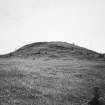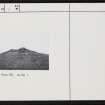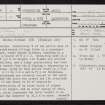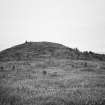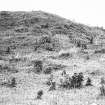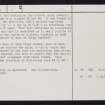Cnocan Sithean, Machrihanish
Cairn (Bronze Age), Cist (Bronze Age)
Site Name Cnocan Sithean, Machrihanish
Classification Cairn (Bronze Age), Cist (Bronze Age)
Canmore ID 38426
Site Number NR62SW 2
NGR NR 6446 2065
Datum OSGB36 - NGR
Permalink http://canmore.org.uk/site/38426
- Council Argyll And Bute
- Parish Campbeltown
- Former Region Strathclyde
- Former District Argyll And Bute
- Former County Argyll
Field Visit (22 October 1959)
NR62SW 2 6446 2065.
(NR 6446 2065) Cnocan Sithean (NR) (Tumulus) (NR)
OS 6" map (1924)
A cairn, generally as described.
Surveyed at 1:2500.
Visited by OS (WDJ) 22 October 1959
Field Visit (May 1962)
Cairn, Machrihanish.
Immediately S of the public road at the E end of Machrihanish village there is a prominent grass-grown mound, named Cnocan Sithean, standing in a level field at a height of 8m OD. Measuring some 24m in diameter and 3.5m in height, its flanks are scarred with numerous hollows, and a large quarry-scoop has been driven into the centre from the E leaving a depression in the top 1.2m deep; lying in this hollow there is a flat slab measuring 1.1m by 0.6m and 0.15m in thickness. Much of the disturbance was probably caused in the early 19th century when the cairn was opened and its structure examined (Seton 1831, 43). It was found to be of composite construction, consisting of an inner cairn of stones measuring 2.4m in height, and an outer casing of sand, earth and turf, which increased the total height to as much as 4.6m and the diameter to 30.5m or more. Beneath the inner cairn, and resting on the natural sandy subsoil, there was a large cist aligned NE and SW. It was formed of two side-slabs, two end-slabs, and a massive cap-stone measuring 1.5m by 1.2m and up to 0.36m in thickness; the floor consisted of sand. This cist contained an incomplete adult skeleton and what is described as "a small portion of a substance like the leaves of a plant, blackish or dark grey, which crumbled to dust on being handled".
Mention is also made of some large stones, said to have stood at one time outside the cairn on the N, which had already been removed by the time the excavation took place. The excavator, however, was able to assert that the central cist was in direct alignment with these stones, and this suggests and interesting comparison with the situation at Ballochroy (see NR75SW 2 and NR75SW 3 ) where a large cist, built above ground and originally covered by a cairn, and three standing stones are situated close together in a straight line running E and W.
RCAHMS 1971, visited May 1962
644 206 cclvii













